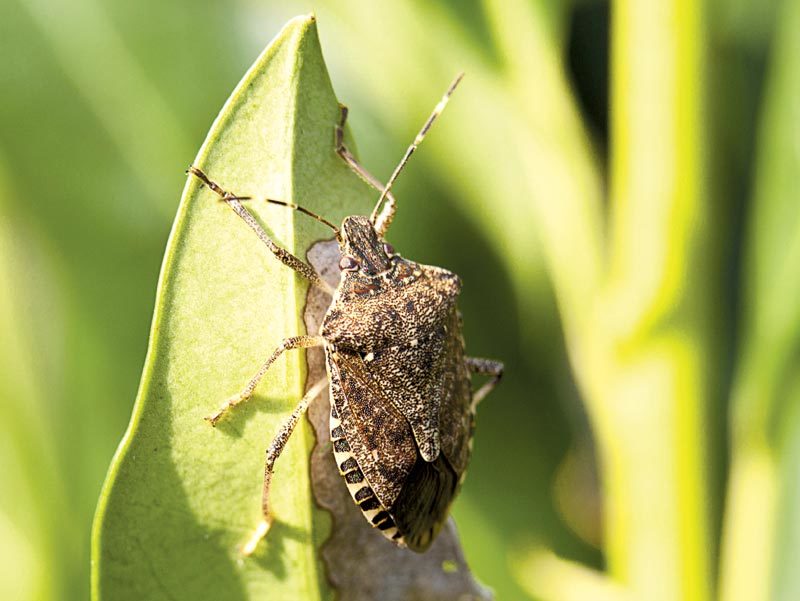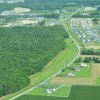Cue the apocalypse music and dim the lights. Marching into towns and farm fields across the state is the brown marmorated stink bug.
The stink bug, as it is commonly called, is not only ugly, but when squished, it smells foul.
It chows down on plants and vegetables, ruining them, and that makes stink bugs more than a small nuisance for farmers and growers in Delaware. Stink bugs puncture commercial crops and ornamental plants, spreading destruction across the agriculture industry.
These brown, flat-backed pests hail from China and the Far East, but in the U.S. they have taken up residency in Delaware and many other states.
While stink bugs may be just a nuisance for homeowners, they are downright destructive for farmers.
“They actually damage the fruit of vegetables,” said Milford-area farmer Bob Russell. “On ripe tomatoes, they leave gold specks where they have chewed.”
Stink bugs are having a great time reproducing and living here in Delaware.
“They come from overseas, so they have no natural enemies in the U.S.,” Russell said.
The University of Delaware is researching the stink bug from two angles.
First, researchers are looking at ways to reduce the stink bug population, and second, they are working with growers across the state to learn more about stink bug activities.
UD researchers Brian Kunkel and Joanne Whalen hope their research leads to a better understanding of this invasive insect, while helping farmers combat the damage it causes.
Infiltrating the First State
Some stink bugs are native to the United States, but the problem pest – the brown marmorated stink bug – has dramatically increased in numbers, Kunkel said.
“Brown marmorated stink bugs are agricultural pests in their native land, but there, this insect pest has a complement of natural enemies,” Kunkel said.
“Since its accidental introduction in the U.S. (some believe as early as 1996) these pests have been moving from Allentown, Pa. to surrounding states with little natural-enemy pressure.”
They arrived in Delaware as hitchhikers. They are now found in 24 states.
“It feeds on fruit trees, vegetable crops and ornamental plants,” Kunkel said. “We are unsure what the conditions were last year that caused such an explosion of population growth over the previous years. The feeding damage caused on fruits and vegetables makes them unsalable in fresh markets and sometimes for processing.”
Kunkel said University of Delaware research is partnering with other states under a grant to find ways to control the pest and learn more about it.
One reason stink bugs are turning up here is the state’s proximity to the initial introduction location of Allentown. Populations tend to be larger in northern regions of the state.
“Delaware has a strong agricultural community, growing a variety of crops, and some of these are plants the stink bugs will eat,” Kunkel said. “Other factors contributing to stink bug populations in Delaware are being investigated.”
Research at UD
Joanne Whalen, extension specialist for the University of Delaware, is working directly with ornamental growers to learn more about how stink bugs operate.
Projects will look at possible natural enemies, including an idea to bring in an Asian wasp. A nonstinging Asian wasp has been shown in field tests to eliminate stink bug eggs before they hatch. This could slow the increase of stink bug populations here.
Researchers will also look at which plants the stink bug prefers and determine if an insecticide could help growers keep the bugs away from plants.
“This research will eventually provide farmers with a better understanding of stink bug biology, such as when they become active and what are some of the plants they prefer to eat,” Kunkel said. “The research is trying to help farmers understand the insect pest and manage it in the most environmentally friendly manner possible.”
Impacts on Delaware
According to the Delaware Department of Agriculture, data colleted in 2007 shows more than 10,000 acres were harvested for fresh-market vegetables, valued at $29 million; more than 30,000 acres of processing vegetables, valued at $23 million, and greater than 120,000 acres of soybeans were harvested, valued at $31 million.
The greenhouse and nursery market was responsible for generating over $29 million in receipts in Delaware in 2007 as well.
“In 2007, 41 percent of the acres of land area in Delaware were farms,” Kunkel said. “The impact stink bugs could have on harvestable, salable crops in Delaware could be extensive since this insect has shown the ability to damage both fresh-market and processing fruits and vegetables.”
How do stink bugs harm crops?
Stink bugs have piercing, sucking mouthparts and use these to feed on plants. They stab the plant with their mouthparts, inject saliva with enzymes to help break down the plant or fruit and then suck it out.
Puncture wounds caused by stink bugs may have yellowish holes around the feeding site. Their feeding also ruins seeds and decreases yields for farmers.















































